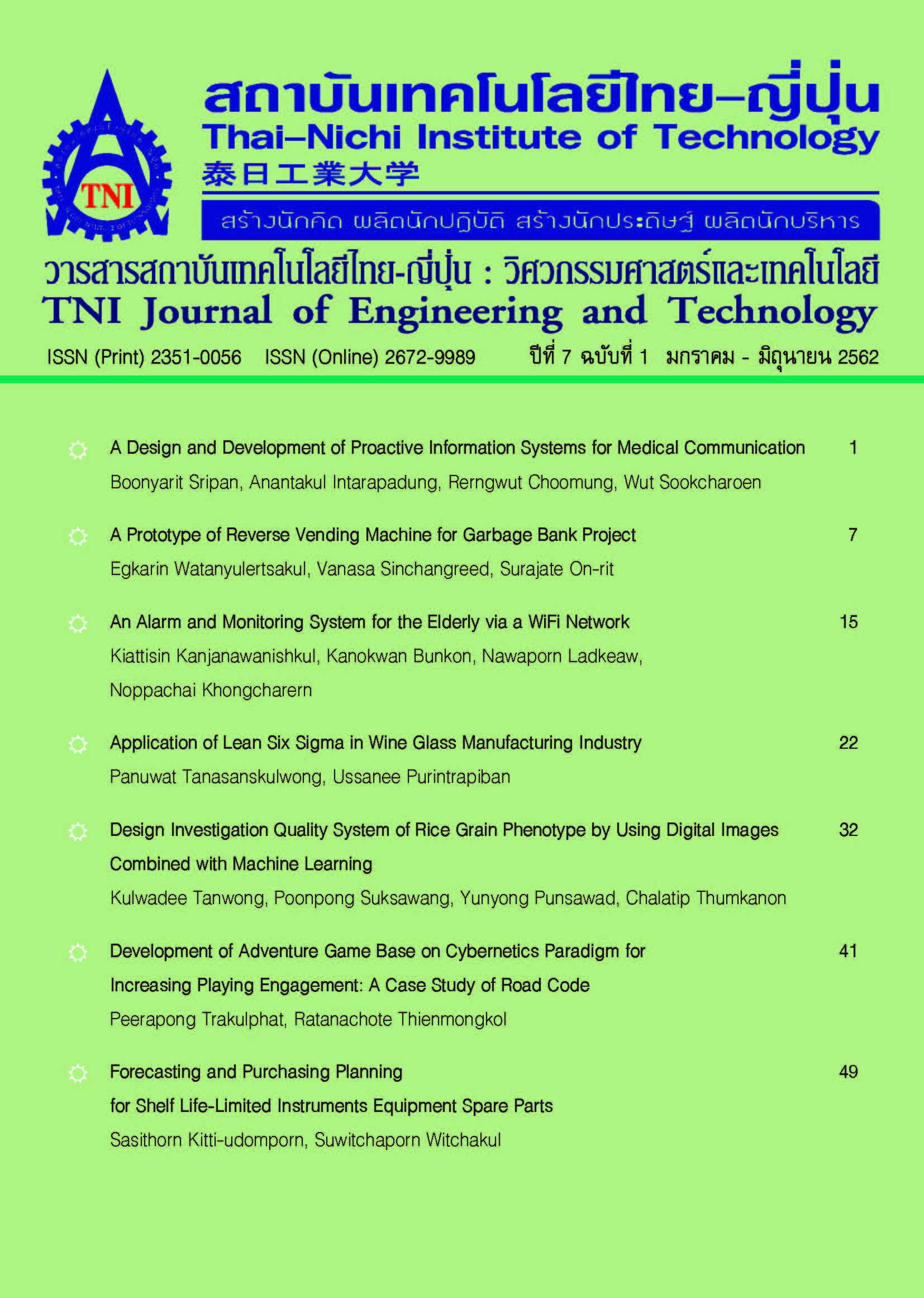Application of Lean Six Sigma in Wine Glass Manufacturing Industry
Main Article Content
Abstract
Manufacturing in today’s Glass Industry is rapidly changing as the result of the intense competition in the market nowadays. The organizations will have to be continuously developed in order to improve the production especially in term of cost reduction and price to be more competitive in the world market. This research aims to apply Lean Six Sigma for the production process improvement. It consists of five basic phases. The Define phase is the first phase of Lean Six Sigma. In this phase, a problem statement was set that was to reduce the percentage of non-conforming wine glass with non-flat at the bottom. The next one is the Measure phase. The precision and accuracy of the measurement system were analyzed. The third phase is the Analysis phase. To investigate the root causes of the problem, the Physical phenomena – Mechanism Analysis was applied. The following phase is the Improve phase. The statistical techniques were used to determine the appropriate levels of the process parameters that lead to the minimum number of non-flat wine glass foot. The fifth phase is the Control phase. To ensure the process being managed and monitored properly, the controlling methods was proposed. As shown in the results, the percentage of non-conforming products had been decreased from 3.20% to 1.73%, which it is even lower than the target set.
Article Details
Article Accepting Policy
The editorial board of Thai-Nichi Institute of Technology is pleased to receive articles from lecturers and experts in the fields of engineering and technology written in Thai or English. The academic work submitted for publication must not be published in any other publication before and must not be under consideration of other journal submissions. Therefore, those interested in participating in the dissemination of work and knowledge can submit their article to the editorial board for further submission to the screening committee to consider publishing in the journal. The articles that can be published include solely research articles. Interested persons can prepare their articles by reviewing recommendations for article authors.
Copyright infringement is solely the responsibility of the author(s) of the article. Articles that have been published must be screened and reviewed for quality from qualified experts approved by the editorial board.
The text that appears within each article published in this research journal is a personal opinion of each author, nothing related to Thai-Nichi Institute of Technology, and other faculty members in the institution in any way. Responsibilities and accuracy for the content of each article are owned by each author. If there is any mistake, each author will be responsible for his/her own article(s).
The editorial board reserves the right not to bring any content, views or comments of articles in the Journal of Thai-Nichi Institute of Technology to publish before receiving permission from the authorized author(s) in writing. The published work is the copyright of the Journal of Thai-Nichi Institute of Technology.
References
W. Suharitdamrong and P. Leesupsuk, Tool Lean Six Sigma. (In Thai). Bangkok: E.I.Square, 2011.
K. Shirose, PM Analysis. (In Thai). Bangkok: Technology Promotion Association (Thailand-Japan), 2003.
W. Boonpree, “Reducing defect in the manufacturing process of plastics factory by applying Six Sigma Methodology,” RESEARCH AND DEVELOPMENT JOURNAL, VOL. 22, NO. 1, 2011.
K. Kowit and A. Raknoi, “Defect Reduction in Spring Assembly Process by Applying Lean Six Sigma Solution : A Case Study of a Electronic Factory,” (In Thai). presented at the 34th National Graduate Research Conference, Khon Kaen University, 2015, pp. 255–267.
V. R. Morais, S. D. T. de Sousa, and I. da Silva Lopes, “Lean Six Sigma Project for Productivity Enhancement,” in Transactions on Engineering Technologies, 2016, pp. 207–221.
L. Steere, M. Rousseau, and L. Durland, “Lean Six Sigma for Intravenous Therapy Optimization: A Hospital Use of Lean Thinking to Improve Occlusion Management,” Journal of the Association for Vascular Access, vol. 23, no. 1, pp. 42–50, Mar. 2018.
S. Indrawati and M. Ridwansyah, “Manufacturing Continuous Improvement Using Lean Six Sigma: An Iron Ores Industry Case Application,” Procedia Manufacturing, vol. 4, pp. 528–534, Jan. 2015.
C. Surachet and P. Ussanee, “Application of P-M Analysis for increasing the availability rate of CNC Laser Cutting Machine in a Sheet Metal Process,” presented at the 7th National Conference of Industrial Operations Development, Nonthaburi, 2016.
K. Teerapat “Expenses Reduction of Claim from Scratch Defects on Work Pieces in Sheet Metal Fabrication Industry,” (In Thai). Master’s thesis (Production Engineering), King Mongkut's University of Technology Thonburi, Bangkok, Thailand, 2011.
N. Laorodphan, Glass Production Industry. (In Thai). Chiang Mai: Maejo University, 2015
K. Ploypanicharoen, Principle of Quality Control. (In Thail). Bangkok: Technology Promotion Association (Thailand-Japan), 2007.


